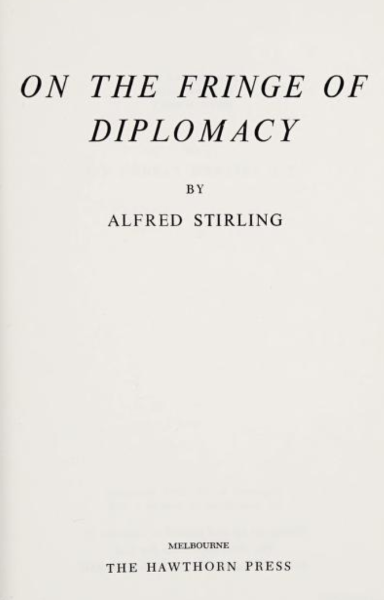Alfred Stirling, On the Fringe of Diplomacy (1973)
Alfred Stirling was a distinguished Australian diplomat and a close personal friend of Robert Menzies.
Born in Melbourne in 1902 as the son of an accomplished surgeon, Stirling was Dux of Scotch College, studied French at the University of Melbourne, and won a scholarship to attend Oxford. After the latter he returned home and was called to the Victorian Bar, working for a time as Menzies’s legal junior and evidently impressing in the role.
While practicing law, Stirling pursued a passion for international relations, becoming Honorary Secretary of the Victorian branch of the Australian Institute for International Affairs and serving as a delegate to the British Commonwealth Relations and International Public Relations conferences in Canada. When Menzies joined federal politics and became Attorney General in 1934, he appointed Stirling as his private secretary.
Undoubtedly helped by this connection, after a couple of years Stirling moved into the Department of External Affairs. Posted to London in 1937, he worked with the British Cabinet Office, the Foreign Office and other agencies throughout the war-period, acting as ‘the eyes and ears’ for his department on all major international developments at a time when Australia had few other overseas posts. During this time he worked closely with High Commissioner Stanley Melbourne Bruce, a relationship that would inform Stirling’s 1974 book Lord Bruce: The London Years
The next elevation came curtesy of John Curtin, who appointed Stirling High Commissioner to Canada (where he could make use of his fluency in French) shortly before the Prime Minister passed away in 1945. It would prove to be the start of a record run of diplomatic appointments, including Minister to Washington (1947-8), High Commissioner to South Africa (1948-50), Ambassador to Holland (1950-5), Ambassador to France (1955-9), Ambassador to the Philippines (1959-62), Ambassador to Italy (1962-7) and simultaneously Greece (1964-5). Many of these postings were new creations of the Menzies Government, as Menzies went out of his way to establish and then grow Australia’s diplomatic presence as distinct from the British, starting with Menzies’s appointment of Australia’s first three diplomatic missions outside of the Empire during his first stint as Prime Minister.
During the Menzies era Stirling’s postings placed him in the thick of intense discussions, particularly over Dutch New Guinea, where he helped to persuade successive Dutch coalition governments to hold to their policy of opposition to Indonesian territorial claims in line with the Australian Government’s wish to maintain a buffer zone between Indonesia and Australia’s Papua New Guinea territory. Likewise, Stirling’s French posting coincided with the rapid and dramatic events of the Suez Crisis in which Menzies played a central role. In more restrained circumstances, Stirling used his postings in Holland and Italy to lobby for migrants on ‘populate or perish’ lines. The latter was not without controversy, as the ‘Loyal Orange Lodge’ publicly complained about the influx of new Catholics to Australia.
On the Fringe of Diplomacy is a selection of speeches, personal accounts, and other material garnered from the full course of Stirling’s diplomatic career ‘alive with anecdote and wit, and full of erudition – doubtless garnered by painstaking research, yet worn ever so lightly’ as one reviewer described the book. Stirling dismissed the cynical definition of a diplomat as ‘a person paid to lie for his country’, instead insisting that he was ‘a person whose duty it was to make friends for his country’. The book is notable not just for its insights into diplomacy, and political figures like Charles de Gaulle and Carlos Garcia, but also into the cultures and people Stirling encountered, with his comments on the Philippines, his only Asian posting, being particularly enlightening.
The book is dedicated to Menzies and he is mentioned several times throughout, with an extended extract of him comparing Italian migration to the Roman conquest of Britain and an anecdote about Menzies learning ‘the Ten Commandments of Dutch Gin’.
His copy of the book contained in the Menzies Collection is inscribed ‘For Robert Menzies with affection’. It is one of at least 15 inscriptions from Stirling in the Menzies Collection, an unmatched number that attests to the closeness of their relationship. Particularly touching is the very last of these inscriptions, written in 1975 when Menzies’s health had well and truly begun to deteriorate. While Stirling normally signed off noting his affection for Menzies, in this instance in A Distant View of the Vatican Sterling signed off ‘with love’.
You might also like...
Sign up to our newsletter
Sign up for our monthly newsletter to hear the latest news and receive information about upcoming events.


